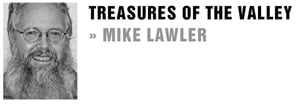
My good friend Art Cobery is about to shout a big fat “I told you so!”
For over a decade, Art, like a geology-themed Paul Revere, has been riding the streets of Crescenta Valley crying, “The debris flows are coming! The debris flows are coming!” Cobery is CV’s “Flood Expert,” using a backdrop of the history of the valley as a vehicle to teach about potential catastrophic futures.
It’s been a decade now that Cobery has been giving lectures to any interested local groups that will listen to the history of floods in CV, concentrating mainly on the catastrophic ’34 flood. He’s done literally hundreds of these programs over the years, and I’ve been to probably a dozen of them. They’re fascinating, and I never tire of them.
His programs usually run like this: He starts with the November ’33 fire that burned off the front of the San Gabriels, and then he jumps to the big rains that followed a month later. From there he follows the gigantic midnight debris flow down Pickens and Hall-Beckley Canyons, crossing Foothill Boulevard as a roaring, 20-foot-high churning wall of rock and mud and tearing through the sleeping neighborhoods below. He gets into some good stories of tragedy and heroism in the flood plain, and talks extensively about the flood control system that was built afterward. All of this is mixed with a healthy dose of geology, and info on how dynamic the San Gabriel Mountains are.
Although he praises the flood control system, he wraps up his talks with the tale of one of the system’s most dramatic failures, the Pinecrest Flood of 1978, and frames that story as a cautionary tale.
Cobery details how the flood control system works: The rocks and mud flow down the canyons and into the deep debris basins. Once the flow stops behind a basin’s dam, the debris mass separates. The rocks and dirt sink to the bottom, and the water is drained off the top, shooting down the concrete channels to the ocean. The failure of this system happens when the basin is completely full of rocks. Then the debris mass can’t settle out, and jumps right over the top of the basin’s dam. It flows into the concrete channel, clogs up, and jumps out of the channel and into the street – which is exactly what happened in 1978 on Pine Cone Road. The street becomes the channel, and the flow can damage the houses at the sides and bottom of the street.
How fast do the debris basins get full? In a hard rain, combined with bare hillsides, those deep basins can fill in minutes!
It’s been over 30 years since our last big flood in La Crescenta and Cobery has been telling his tales of disaster to a mostly disaffected audience. It’s history, it happened long ago, to other folks. Most of the people who lived in Pinecrest or at the base of the Verdugos or at the top of Ocean View for the floods of ’69, ’73, and ’78 are gone now, and have been replaced with a new generation who have no idea of the awesome power a wall of mud can generate, or the speed with which it can fly down a canyon and through a neighborhood. To many, these freeway barriers now lining some streets must seem like a ridiculous overreaction on the part of the county, and at the very least, an incredible nuisance.
Cobery, and others who have studied CV’s history, see those barriers as not enough.
The famous author John McPhee wrote an article in the ’80s about the geology of the San Gabriel Mountains butting up hard against an expanding suburban landscape, aptly called “Los Angeles Against the Mountains.” In it, he describes the San Gabriels as the fastest growing – and the fastest eroding – mountains in the world. Recurring earthquakes have shattered the granite mountains like safety glass, and chunks of it constantly fall onto the city below.
You know all those rocks in your yard, and those decorative boulders that look so great in your neighbor’s landscaping, or that dot CV Park? Those didn’t grow there. They rolled there! Those massive rocks were pushed down the hill by water and mud, most times in a single flood! And there’s more up there, ready to roll.
For the Internet-savvy, McPhee’s articles – now a standard of college geology classes – can be found online. Those of us who haven’t shaken our paper addiction can find this particular article published in his compilation of “man against nature” writings, a book titled “The Control of Nature,” available at any library or bookstore.
And for those who like the spoken word, who want to hear the truth from a master storyteller, Art Cobery is still out there, making the rounds. You may want to attend one of his talks locally in the next few months. But hurry … you’ll want to catch his lecture before he adds the chapter on the Big Flood of ’09!
Mike Lawler is the president of the Historical Society of the Crescenta Valley.
He can be reached at lawlerdad@yahoo.com.
